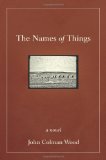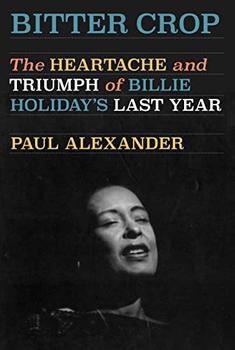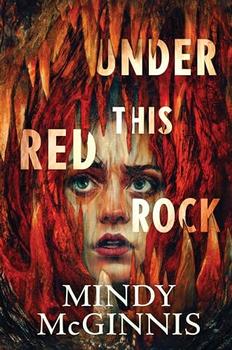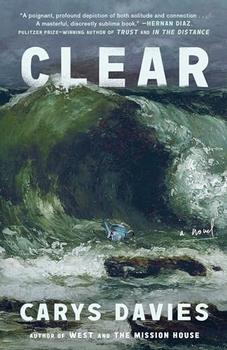Summary | Excerpt | Reviews | Beyond the Book | Read-Alikes | Genres & Themes | Author Bio

 Book Reviewed by:
Book Reviewed by:
Kim Kovacs
Buy This Book
This article relates to The Names of Things
The Names of Things is set in the Chalbi, a desert in northern Kenya near the border with Ethiopia (marked "A" on the map below).
 The Chalbi, which means "bare and salty" in the local language, was once part of Lake Turkana, the largest permanent desert lake in the world. It is an immense flat expanse of clay and white salt stretching approximately 62,000 square miles (100,000 square kilometers), surrounded by volcanoes and ancient lava flows.
The Chalbi, which means "bare and salty" in the local language, was once part of Lake Turkana, the largest permanent desert lake in the world. It is an immense flat expanse of clay and white salt stretching approximately 62,000 square miles (100,000 square kilometers), surrounded by volcanoes and ancient lava flows.
Kenya's only true desert, the Chalbi is one of the hottest and most arid regions in the world. The area receives less than five inches of rain in a standard year, but even that is sporadic; some years only a trace of rainfall reaches the desert floor. Whatever little rain falls arrives during one of two "rainy seasons" -- a longer period in March and April and a shorter one in November. During these periods, large shallow lakes form across the former lakebed. February is the warmest month with an average temperature of 98 °F, but temperatures can top 140 °F.
It is home to lions, ostriches, oryx (a large antelope) and the Grévy's zebra (the largest and the wildest of the three zebra species).
The Gabra people (pronounced GAH-brah and also spelled Gabbra and Gebra), who feature prominently in the novel, call this wasteland home. They are a tribe of camel-herding nomads closely related to the Rendille (of Eastern Kenya) and Somali peoples, all three of whom are referred to locally as the warra dassee -- "people of the mat" -- in reference to the mat-covered, portable tents they use. In addition to camels, the Gabra also rely on sheep and goats for food and for religious sacrifices.
 The Gabra are traditionally monotheistic, worshipping a god they call Waka (also spelled Waqqa, Waaqa or Waaka). The religion is influenced by Islam, and shows many similarities to it.
The Gabra are traditionally monotheistic, worshipping a god they call Waka (also spelled Waqqa, Waaqa or Waaka). The religion is influenced by Islam, and shows many similarities to it.
The Gabra's population is difficult to determine, with estimates ranging from 30,000 to 90,000 individuals. A group of about 75 people (10 to 15 families), makes up a village or ola. Each ola has approximately 25 houses, called mandasse, which are light, dome-shaped tents made of acacia roots and covered with grass mats and camel hides. The mandasse are owned, cared for and moved by the women of the tribe, and can be quickly disassembled and stowed on a camel for transport (the ola may move up to twelve times a year in search of water and better grazing for the animals).
The men are responsible for herding, feeding and watering the camels, while children care for smaller animals. Watering may be a very complicated affair, particularly during the dry seasons, as wells can be very deep, requiring up to eight men in a sort of "bucket brigade" to bring water up.
Men are also responsible for governance. Based on his competence and leadership qualities, one abba-olla - "father of the village"- is selected to lead. Elders gather in assemblies to discuss problems and make decisions related to the community, but the abba-olla generally makes the final decision. The tribe functions communally; no one is permitted to go hungry, be without animals, or is refused hospitality or assistance.
You can take a virtual trek through the Chalbi by following the video below:
Filed under Places, Cultures & Identities
![]() This article relates to The Names of Things.
It first ran in the July 25, 2012
issue of BookBrowse Recommends.
This article relates to The Names of Things.
It first ran in the July 25, 2012
issue of BookBrowse Recommends.





The Flower Sisters
by Michelle Collins Anderson
From the new Fannie Flagg of the Ozarks, a richly-woven story of family, forgiveness, and reinvention.

The House on Biscayne Bay
by Chanel Cleeton
As death stalks a gothic mansion in Miami, the lives of two women intertwine as the past and present collide.

The Funeral Cryer by Wenyan Lu
Debut novelist Wenyan Lu brings us this witty yet profound story about one woman's midlife reawakening in contemporary rural China.
Your guide toexceptional books
BookBrowse seeks out and recommends the best in contemporary fiction and nonfiction—books that not only engage and entertain but also deepen our understanding of ourselves and the world around us.